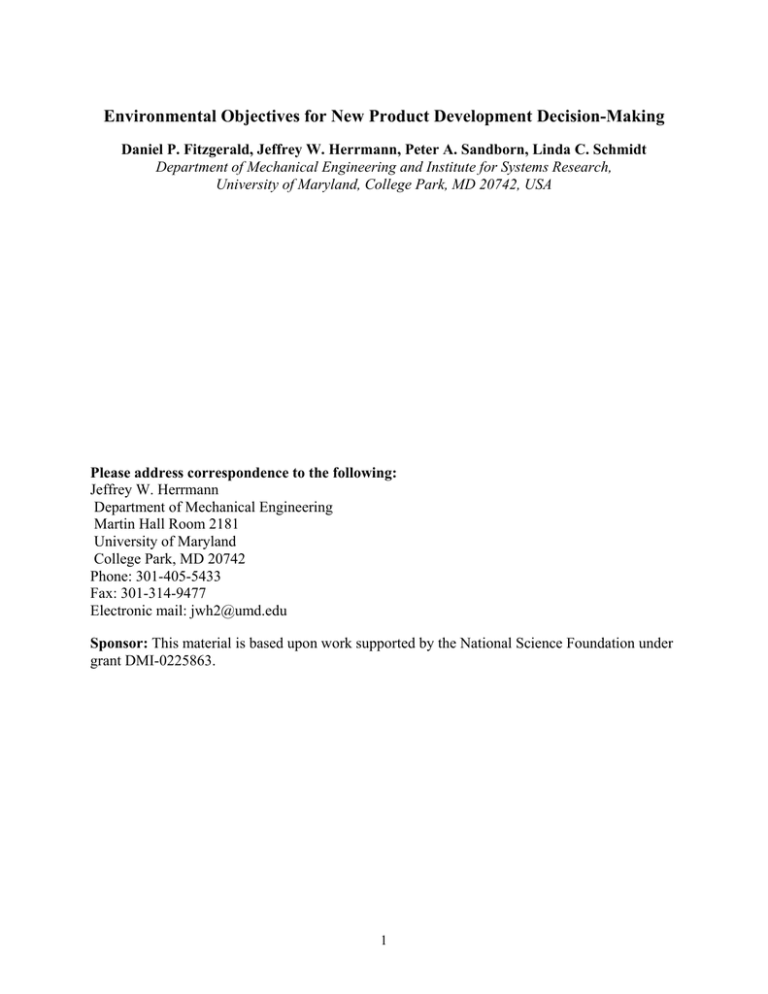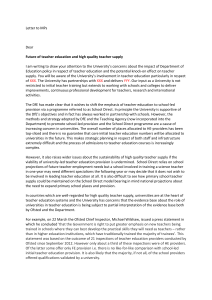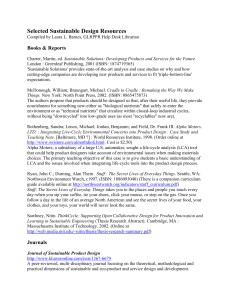Environmental Objectives for New Product Development Decision-Making
advertisement

Environmental Objectives for New Product Development Decision-Making Daniel P. Fitzgerald, Jeffrey W. Herrmann, Peter A. Sandborn, Linda C. Schmidt Department of Mechanical Engineering and Institute for Systems Research, University of Maryland, College Park, MD 20742, USA Please address correspondence to the following: Jeffrey W. Herrmann Department of Mechanical Engineering Martin Hall Room 2181 University of Maryland College Park, MD 20742 Phone: 301-405-5433 Fax: 301-314-9477 Electronic mail: jwh2@umd.edu Sponsor: This material is based upon work supported by the National Science Foundation under grant DMI-0225863. 1 Environmental Objectives for New Product Development Decision-Making Abstract Organizations that develop new products need to consider many factors related to the environmental impact of their products, including government regulations, consumer preferences, and corporate environmental objectives. To date, such organizations have struggled to find the best way to incorporate environmental issues into new product development decisionmaking. This paper compares environmental objectives to other types of objectives that influence decision-making during new product development. Specifically, this paper examines objectives related to product performance, unit cost, time-to-market, development cost, and safety. Based on the conclusions of this analysis, this paper describes how the procedures used to consider safety issues can be expanded to include environmental concerns quite easily, thus creating a practical and effective design for environment (DFE) process. To show the effectiveness of this type of DFE process, the paper shows how it embodies principles that lead a firm towards becoming an ecologically sustainable organization. This approach has been used at a consumer products manufacturer. Keywords: new product development, decision-making, environmental objectives, safety 1. Introduction Developing the first generation of products contributing to a sustainable world requires identifying a new set of business strategies and design and manufacturing tactics. Developing products for a sustainable way of life may be a difficult task today, but there exist many benefits to moving in this direction. Environmental objectives are increasingly important as companies seek to satisfy environmental regulations, to attract consumers who value environmentally benign products, and to be good citizens. The opportunity to create environmentally benign products occurs during the product design phases, as discussed by many authors, including Handfield et al. (2001), Fiksel (1996), Bras (1997), and Ashley (1993). So far, however, companies have had trouble incorporating the environmental objectives into the new product development process. Decision-making is an important activity in new product development, and there exist a great variety of decisions that need to be made. Generally speaking, these fall into two types: design decisions and management decisions. Design decisions: What should the design be? Design decisions determine shape, size, material, process, and components. These generate information about the product design itself and the requirements that it must satisfy. Management decisions: What should be done? Management decisions control the progress of the design process. They affect the resources, time, and technologies available to perform development activities. They define which activities should happen, their sequence, and who should perform them. That is, what will be done, when will it be 2 done, and who will do it. The clearest example is project management: planning, scheduling, task assignment, and purchasing. In studying design projects, Krishnan and Ulrich (2001) provide an excellent review of the decision-making in new product development, organized around topics that follow the typical decomposition of product development. Herrmann and Schmidt (2002) describe the decisionmaking view of new product development in more detail. Traditionally, factors such as product performance and product cost have dominated design decisions, while time-to-market and development cost have influenced management decisions. Of course, many decisions involve combinations of these objectives. See, for example, the tradeoffs discussed by Smith and Reinertsen (1998). In a capitalist, free enterprise system, manufacturing firms serve the interest of their community by employing workers, purchasing materials, producing goods, generating profits, and not harming the community. Guiding the activities of a firm are the ethical standards of the community, the firm’s civic responsibilities, regulatory constraints, and the values and consciences of the owners and executives. Making a profit is certainly an important objective to manufacturing firms. Generally, a product development organization estimates the profitability of a new product based on unit costs, development costs, marketing costs, sales price, and projected sales. Such analysis is commonly used early in the vehicle development process (Walton, 1997). Executives approve funding for the product development project based on such analysis. Most decision-makers do not explicitly consider profit, though that is the overall objective of the manufacturing firm, because decision-making is “loosely coupled” (Simon, 1997). Profit is an indirect influence on most decision-makers. The mechanisms linking decision-makers to the overall corporate goals are constraints and incentives such as schedules, rewards, and penalties. Other corporate objectives indirectly influence decision-makers throughout the firm in the same way. As described below, considering environmental issues during decision-making in new product development, while certainly more important than ever before, has been less successful than considering other objectives. To understand this more completely and to identify a useful solution, this paper analyzes the objectives that influence decision-making in new product development. Section 2 discusses the difficulties faced by product development organizations when considering environmental issues. Section 3 analyzes environmental objectives. Section 4 discusses other objectives that influence new product development decision-making, including product performance, product cost, development metrics, and safety. Section 5 translates accepted safety principles into environmental principles. Section 6 evaluates whether the translated environmental principles lead to an effective DFE process. Section 7 concludes the paper. 3 2. The Dilemma of New Product Development The need to consider environmental issues during new product development is continually increasing. Although some firms embrace this trend and try to attract environmentally conscious consumers by creating innovative designs and using environmentally benign materials, most product development organizations view environmental issues as a distraction. Moreover, “even when motivated to design for the environment, product designers are unsure exactly how to proceed. They face an open-ended problem about which information is scarce” (Lennox, 2000). Consequently, product development organizations have spent a great deal of effort developing tools to help designers create environmentally benign products. The two major classes of tools are life cycle assessment (LCA) and design for environment (DFE) tools (Fiksel, 1996). LCA provides a fundamental methodology that evaluates the environmental impact associated with a product during its complete life cycle. DFE tools are design decision support tools (including checklists, guidelines, and scorecards) that help a designer reduce these impacts by improving the product design. DFE incorporates the consideration of national regulations, human health and safety, hazardous material minimization, disassembly, recovery, recycling, and disposal into the design process. When implemented, DFE tools and guidelines become part of the long list of items an engineer must consider when designing a new product. Environmental concerns must be balanced against other design considerations to optimize a design. Some designers view DFE as simply calculating an environmental measurement, similar to estimating cost. This perception is due to the trend of companies implementing standalone DFE tools without explanation. As Lindahl (2005) states, “When the designers and actual users of the methods do not understand the reason why, or experience any benefits from using the DFE methods, there is a risk that they utilize the methods but do not use the results, or that they run through the method as quickly as possible.” Therefore, designers produce an environmental output and consider the environmental work finished. Unfortunately, there exist serious obstacles to the effective use of LCA and DFE tools. Two of the most significant obstacles are the difficulties acquiring the needed data and the challenges developing realistic, appropriate metrics of environmental impact. In addition, these tools are ineffective because “they [are] far too time consuming to be useful to designers and often too specific for general design use” (Lennox, 2000). Consequently, LCA and DFE tools are, generally, not integrated with the other activities and tools used in the product development process. That is, the information flow required for LCA and DFE tools to be effective is inconsistent with the new product development processes that are present, and the information generated by LCA and DFE tools do not match the objectives that influence new product development decision-making. The result is often a post-design, standalone, environmental review of a product. 3. Environmental Objectives Under pressure from various stakeholders to consider environmental issues when developing new products, manufacturing firms have declared their commitment to environmentally responsible product development and have identified relevant goals: 4 1. Comply with legislation: Products that do not comply with a nation’s environmental regulations cannot be sold in that nation. 2. Avoid liability: Environmental damage caused by a product represents a financial liability. 3. Satisfy customer demand: Some consumers demand environmentally responsible products, and retailers, in turn, pass along these requirements to manufacturers. 4. Participate in eco-labeling programs: Products that meet requirements for ecolabeling are more marketable. 5. Enhance profitability: Certain environmentally friendly choices such as remanufacturing, recycling, and reducing material use makes good business sense and have financial benefits. 6. Behave ethically: Being a good steward of the planet’s resources by considering the environment during the product development process is the right thing to do. Despite the high profile given to these objectives at the corporate level, product development teams assign a “back-burner” status to environmental issues. Environmental objectives, for the most part, are driven by regulations and social responsibility, and reducing environmental impact doesn’t clearly increase profit. Product managers are not willing to compromise profit, product quality, or time-to-market in order to create products that are more environmentally benign than required by regulations. (The exceptions are those organizations that court environmentally conscious consumers.) As responsible members of society, product development organizations should incorporate the idea of sustainability into both engineering and manufacturing processes. When the benefits of being socially responsible are not enough to shape behavior, nations impose restrictions on materials and processes to limit the amount of environmental damage an organization can commit. The current regulatory situation reflects the need to influence manufacturers through penalties. Environmental performance, however, is measured using multiple metrics, some of which are qualitative. Moreover, these metrics may seem irrelevant to the firm’s financial objectives. Measuring environmental performance, especially life-cycle analysis (LCA), can require a great deal of effort. With environmental performance it is harder to make trade-offs. It is not clear how to select between design alternatives because there is no aggregate measure to calculate. One designer presents an excellent example: You have two ways of building a part. One option is based on metal. Metal is heavy (thus, it consumes more resources). It also creates waste during the actual manufacturing process (in form of sludge). However, it can be recycled when it reaches the end of its product life. In contrast, we make the product out of graphite. This part is lighter (which means it consumes less energy in use). In addition, it can be molded rather than 5 machined (again resulting in less waste). However, when it reaches the end of its life, it must be disposed of in a landfill since it cannot be recycled. Which of these two options results in a greener product? (From Handfield et al., 2001) 4. Other Objectives In new product development, many objectives influence decision-making. The following discussion focuses on some of the most important objectives. 4.1 Product Performance Product performance is the most common topic considered when making decisions during product development, whether it is to satisfy given technical specifications, to resolve tradeoffs between multiple performance-related objectives, or to make the product more appealing to the customer (cf. Sandberg, 2001). Based on the organization’s understanding of customer needs, wants, and desires, targets for product performance are set early in the new product development process, a phase that is sometimes called the “fuzzy front end” (Cagan and Vogel, 2002). Customers generally express their preferences in a qualitative manner, favoring, for instance, “smaller,” “lighter,” or “more powerful” products. Therefore, product development teams must determine quantitative technical specifications for measurements such as length, weight, or horsepower using methods like Quality Function Deployment, for instance. These become the targets that the new product should satisfy. However, generally, the nature of these targets is much different from that of regulatory requirements. The product development team will look for ways to exceed the performance targets if feasible and will lower their targets when needed to avoid excessive unit cost or to accelerate the development process. The product profit model (Smith and Reinertsen, 1998) can be used to help make tradeoffs between product performance and the other three traditional product development performance measures: unit cost, development cost, and time-to-market. 4.2 Unit Cost Unit cost is the cost of the material, components, and labor needed to manufacture one unit of the product. Unit cost is an important objective for new product development. An estimate for unit cost may be set early in the new product development process as part of the financial justification for beginning the development effort. But this estimate is a target similar to the product performance targets. The cost of the complete product may be divided into cost targets for each subassembly and component. Since a manufacturing firm pays for the labor, material, and components and has extensive knowledge in this domain, the relationship between product design and unit cost is the one area where the most work has been done, and there exists a large amount of research on technical cost modeling and manufacturability analysis. For more details about cost analysis techniques, see, for example, Otto and Wood (2001). 6 Cost estimation uses a single quantifiable metric (unit cost) with a well-understood unit of measure (dollars per unit) that is clearly related to profitability. The effort required to do cost estimating can be significant for a large product. Due to the importance of cost estimating, many firms have developed and validated cost estimation tools to simplify the effort required to create a cost estimate. Moreover, they may have cost estimating specialists who support a product development team and can produce high-quality cost estimates within a reasonable amount of time. 4.3 Development metrics The time to get the new product to market (the “time-to-market”) and the cost to develop the new product are two other important performance measures that influence new product development decision-making (Smith and Reinertsen, 1998). These are also among the easiest to understand and to measure, because it is clear when the product is launched, and the costs are in the present. These costs include the salaries of the personnel on the product development team and the cost of creating prototypes, conducting testing, and purchasing tooling for the production line, among other items. Although these objectives may not be as exciting as product performance, especially to the design engineers creating the new product, the project managers and their superiors understand their importance and watch them very closely. An alternative that will delay the time-to-market or require additional investment will receive close scrutiny. 4.4 Safety Product safety is an influential factor in almost all products, from aircraft to toys. Safety can be defined as the “condition in which there is a low probability that harm will occur” (Swallom et al., 2003). Manufacturing firms that develop new products have a variety of goals related to product safety: 1. Comply with legislation: Products that do not comply with national safety regulations will not be allowed to be sold. 2. Avoid liability: Consumers who are injured using unsafe products represent a financial liability to the company. 3. Satisfy customer expectations: Consumers expect the products that they purchase to be safe. 4. Conform to standards: Some products are required to conform to certain third-party standards (or certifications) such as UL or CSA before they are sold. 5. Maintain a reputable name: Companies that are repeatedly found guilty of selling unsafe products will develop a bad reputation. 6. Behave ethically: Selling safe products is the right thing to do. 7 Despite the straightforward definition of a concept that is generally intuitive, measuring safety is a challenge. Generally, it is understood that safety depends upon the probability that a hazard will occur and the severity of that hazard. Hazard analysis techniques are useful for organizing data about possible hazards, but they rely upon subjective assessments about the probabilities and estimates of the severity. The hazard analysis does identify areas where a redesign to reduce the hazards would be valuable. In large-scale system acquisition situations, a system safety process is used to identify, track, and reduce hazards through formal assessments and design reviews that occur throughout the development project (Swallom et al., 2003). In a similar manner, most product development organizations implement a formal safety review process to ensure the final product is safe for consumer use. See, for example, Goodden (2000) and Kitzes (1991). Typically, safety reviews are held at pre-determined key points in the product development process. During these reviews, members from the design team and other safety specialists, such as liability and compliance representatives, meet to discuss the current product design. The meetings are run in a brainstorming format and can be guided by a checklist or company specific agenda. One safety specialist is in charge of final decisions concerning safety. Since product safety includes qualitative measures, it is necessary to assess the issue in a meeting format where ideas and issues can be discussed with all interested parties. 4.5. Discussion Based on the above discussion, it is clear that environmental objectives are not similar to the traditional objectives of product performance, unit cost, time-to-market, and development cost. All four objectives directly affect profitability and are closely monitored. Unit cost, time-tomarket, and development cost each use a single metric that is well understood and uncomplicated. Although product performance may have multiple dimensions, these characteristics are quantifiable and clearly linked to the product design. Designers understand how changing the product design affects the product performance. However, the lists of goals with respect to safety and environment are very similar. In fact, some of the goals are exactly the same. Both areas are important but not as closely linked to profitability. Both areas involve subjective assessments on a variety of factors, many of which are qualitative. This suggests that most product development organizations should treat environmental objectives in the same way that they treat safety concerns. It is necessary to assess a product’s environmental performance at key stages in the product development process. Furthermore, since assessing environmental performance requires information from multiple business units within the product development organization, a meeting to discuss the issues with all interested parties is necessary. Thus, for organizations with similar corporate objectives for safety and for environmental issues, expanding the safety review process creates a practical DFE process that should be simple to implement. In spite of this, manufacturing firms with elaborate safety evaluation and verification procedures (used in areas such as aircraft manufacturing) may not require a similarly sophisticated DFE process (unless the product has many environmental concerns, as in automobile manufacturing). 8 In firms that don’t explicitly consider safety during their new product development process, establishing a DFE process will be more work, but the need for a DFE process remains. 4.6. Example: Power Tool Product Development Currently, a leading power tool manufacturer has a new product development process that requires safety reviews during four different stages. Each stage includes many activities as the product design advances from conceptual design to final design. During the safety reviews, reviewers evaluate the assessment, actions, and process of the design team in addressing product safety. This firm’s new DFE process will combine an environmental review with three of the safety reviews. A separate environmental review will be added in one stage because many design decisions are made at this stage. The environmental reviews will be run in the same fashion as the safety reviews. In addition to the environmental reviews, environmental targets will be set at the beginning of the product development process as goals for the new product. The design team will also write a lessons learned summary during final stage to highlight innovative environmental design changes. 5. Translating Safety Principles to Environmental Principles The Consumer Product Safety Commission (CPSC) has used the law, regulations, and published guidelines to help define product safety responsibilities. Kitzes (1991) presents ten principles that can provide a “system safety” approach to assist in the design of safe products. While the list of principles is not exhaustive, they do provide “a concise overview of a reasonably prudent program to reduce product-related injuries.” These principles include the following: 1. Establish and observe a written corporate safety policy. 2. Create an independent (from production and distribution) safety review process. 3. Identify and evaluate the severity and foreseeability of product hazards. 4. Conduct a design review assessing the risk of injury by considering the hazards, the environment, and foreseeable use. 5. Attempt to eliminate hazards. If not possible, reduce the opportunity for injury by guarding against hazards. 6. Warn users of product dangers and motivate them to avoid injury. 7. Promote only the safe use of a product. 8. Maintain safety-related records during the product’s useful life. 9. Continuously monitor the safety performance of the product in the hands of users. 10. Promptly notify product users and institute recall procedures where necessary to substantially reduce or eliminate injury. 9 Based on the conclusion that safety and environmental objectives are similar, these safety principles can be translated directly into environmental principles: 1. Establish and observe a written corporate environmental policy. 2. Create an independent (from production and distribution) environmental review process. 3. Identify and evaluate foreseeable environmental issues. 4. Conduct a design review assessing the environmental risks. 5. Attempt to eliminate environmentally unfriendly products and components. If not possible, attempt to reduce negative environmental metric values. 6. Warn users of environmental hazards and motivate them to protect the environment. 7. Promote only environmentally friendly product use. 8. Maintain environmental records during the product’s useful life. 9. Continuously monitor the environmental impacts of the product. 10. Promptly notify product users and institute recall procedures when necessary to substantially reduce or eliminate environmental damage. Expanding the safety review process creates a DFE process that satisfies the above principles. An effective DFE process helps a company become an Ecologically Sustainable Organization (ESO). Do these principles lead to an effective DFE process? The next section will answer this question. 6. Characteristics of a Successful Ecologically Sustainable Organization An ESO is an ideal product development organization that operates in a way that maintains ecosystem components and functions for future generations (Environmental Protection Agency, 2005). In other words, a company’s positive environmental impacts are greater than or equal to their negative environmental impacts. An ESO is more of an ideal goal than a reality. Handfield et al. (2001) present three propositions that describe ESOs: 1. In ESOs, designers are driven to explicitly consider environmental design decisions by corporate and new product development environmental objectives. 2. ESOs have Environmentally Responsible Manufacturing (ERM) systems that explicitly measure and recognize environmental objectives at major points in the design process; these metrics carry at least the same weight as other design goals (target cost, technical specifications, process specifications, time-to-market, capacity). 3. ESOs successfully integrate environmental issues into the design process by measuring environmental outcomes and integrating them into the strategic planning process. These outcomes form the basis for strategy and designer performance evaluation. 10 Consider a product development organization that uses a DFE process that satisfies the principles listed in the previous section. The firm satisfies Proposition 1 because a corporate environmental policy is established that drives designers to consider general environmental design objectives and an independent environmental review process will contain a step that sets project specific environmental targets (Principles 1 and 2). The firm satisfies Proposition 2 because an independent environmental review process will require engineers to meet at key points within the design process to discuss environmental issues. During these meetings, key environmental metrics will be analyzed and solutions will be proposed (Principles 2 and 5). The firm satisfies Proposition 3 because a final set of metrics will be calculated during the final environmental review and be maintained and monitored to ensure environmental compliance with everchanging requirements. The records will be used as a starting point for next generation product environmental objectives (Principles 8 and 9). Thus, we conclude that implementing a DFE process that expands the safety review process leads a firm towards becoming an ESO, which is a measure of DFE process effectiveness. 7. Conclusion Product development organizations need a DFE process, not just a tool. However, a DFE process that adds a large amount of additional analysis, paperwork, and meetings (all of which add time and cost) is not desirable. Ideally, environmental objectives would be considered in every decision that occurs during new product development, like the objectives of product performance, unit cost, time-to-market, and development cost. However, environmental objectives are much different than these. Instead they more closely resemble safety objectives. One possible approach to remedy this problem is for a product development organization to create a DFE process by expanding a process that the firm may already have in place, the safety review process. In many firms, the safety review process evaluates product safety at various points during the product development process. Therefore, combining the DFE process with the safety review process would require environmental performance to be assessed multiple times during the product development process. This method of incorporating the DFE process into the product development process ensures environmental performance will be evaluated at key points in the design process instead of only after the design is complete. The safety and environmental objectives of product development organizations vary considerably from firm to firm, and each firm uses different mechanisms for addressing these concerns. Certainly, practices that make sense in one domain may be impractical in another. This paper identifies one way to create a DFE process, something that many firms are now attempting to do, and discusses the use of this approach at a power tools manufacturing firm. The paper’s analysis of this approach is based on the similarity of the safety objectives and environmental objectives. In firms where the safety objectives and environmental objectives are quite different in scope, other types of DFE processes will be more effective. Fundamentally, though, a firm still needs a DFE process, not an isolated environmental assessment tool, to achieve their environmental objectives. 11 Acknowledgements The authors greatly appreciate the help provided by Ted Gogoll and Mike Justice. This material is based upon work supported by the National Science Foundation. Any opinions, findings, and conclusions or recommendations expressed in this material are those of the authors and do not necessarily reflect the views of the National Science Foundation. References Ashley S. 1993. Designing for the Environment. Mechanical Engineering 115(3):53-55. Bras B. 1997. Incorporating Environmental Issues in Product Design and Realization. UNEP Industry and Environment 20(1–2):5–13. Cagan J, Vogel CM. 2002. Creating Breakthrough Products: Innovation from Product Planning to Program Approval. Prentice Hall PTR: Upper Saddle River, New Jersey. Environmental Protection Agency. 2005. Terms of environment. Document number EPA175B97001. http://www.epa.gov/OCEPAterms/eterms.html [29 October 2005] Fiksel J. 1996. Design for Environment: Creating Eco-efficient Products and Processes. McGraw-Hill: New York. Goodden R. 2000. Product Liability Prevention - A Strategic Guide. ASQ Quality Press:Milwaukee, Wisconsin. Handfield RB, Melnyk SA, Calantone RJ, Curkovic S. 2001. Integrating environmental concerns into the design process: the gap between theory and practice. IEEE Transactions on Engineering Management 48(2):189-208. Herrmann JW, Schmidt LC. 2002. Viewing product development as a decision production system. DETC2002/DTM-34030, ASME 2002 Design Engineering Technical Conferences and Computers and Information in Engineering Conference, Montreal, Canada, September 29 - October 2, 2002. Kitzes WF. 1991. Safety management and the Consumer Product Safety Commission. Professional Safety, 36(4):25-30. Krishnan V, Ulrich KT. 2001. Product development decisions: a review of the literature. Management Science 47(1):1-21. Lennox M, King A, Ehrenfeld J. 2000. An assessment of design-for-environment practices in leading US electronics firms. Interfaces 30(3):83-94. Lindahl M. 2005. Designers’ utilization of DFE methods. University of Kalmar. http://unit.aist.go.jp/lca-center/lca-activity/symposium/02_sympo/030319_document/S94%20Lindahl.pdf [29 October 2005] Otto KN, Wood KL. 2001. Product Design. Prentice Hall: Upper Saddle River, New Jersey. Sandberg J. 2001. Understanding competence at work. Harvard Business Review 79(3):24-28. Simon HA. 1997. Administrative Behavior, fourth edition. The Free Press:New York. Smith PG, Reinertsen DG. 1998. Developing Products in Half the Time. Van Nostrand Reinhold:New York. Swallom DW, Lindberg RM, Smith-Jackson TL. 2003. System safety principles and methods. In Handbook of Human Systems Integration, Harold R. Booher (ed). John Wiley & Sons, Inc.: Hoboken, New Jersey; 497-540. Walton M. 1997. Car. W.W. Norton & Company:New York. 12





